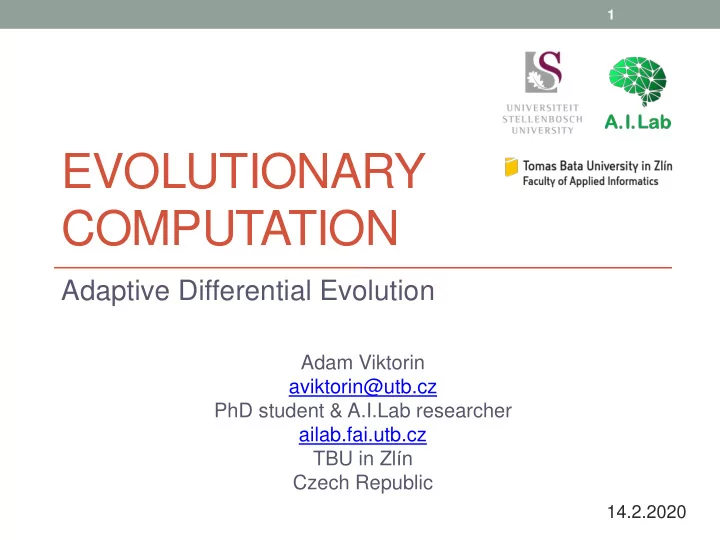

1 EVOLUTIONARY COMPUTATION Adaptive Differential Evolution Adam Viktorin aviktorin@utb.cz PhD student & A.I.Lab researcher ailab.fai.utb.cz TBU in Zl í n Czech Republic 14.2.2020
2 TOC • Differential Evolution • Control parameter adaptation • DISH/DISH-XX • Waste-to-Energy application
3 Differential Evolution • Metaheuristic optimizer / Evolutionary computation technique / Evolutionary algorithm • Rainer Storn & Kenneth V. Price – 1995 • Great for numerical single objective optimization • Given f : A → ℝ , A ⊆ ℝ dim • Find a set of parameters x 0 : • f ( x 0 ) ≤ f ( x ), ∀ x ∈ A Generate random set of solutions (first generation) 1. While stopping criteria not met do 2. Use mutation and crossover operators to produce candidate solutions 1. Select better one from the target and candidate solutions for the next 2. generation Return best-found solution 3.
4 Control parameters 1. Population size – NP 2. Scaling factor – F 3. Crossover rate – CR • User-dependent algorithm setting • Optimization performance – massively influenced • “No free lunch” theorem
5 Population 1. Population size – NP • Range – [4, inf] • Smaller population=> more generations • Larger population => better search space coverage
6 Mutation operator • Example: rand/1 • 𝒘 𝑗 = 𝒚 𝑠1 + 𝐺 ∙ 𝒚 𝑠2 − 𝒚 𝑠3 • 𝑗 ≠ 𝑠1 ≠ 𝑠2 ≠ 𝑠3 F = 0.5 2. Scaling factor – F • Usual range [0, 2]
7 Crossover operator • Example: binomial • 𝑣 𝑘,𝑗 = ൝ 𝑤 𝑘,𝑗 𝑗𝑔 𝑉 0,1 ≤ 𝐷𝑆 𝑝𝑠 𝑘 = 𝑘 𝑠𝑏𝑜𝑒 𝑦 𝑘,𝑗 𝑝𝑢ℎ𝑓𝑠𝑥𝑗𝑡𝑓 3. Crossover rate – CR • Range [0, 1]
8 Selection • Target vs. candidate solution 𝒚 𝑗 vs. 𝒗 𝑗 • • If 𝑔 𝒗 𝑗 ≤ 𝑔 𝒚 𝑗 then u i goes to the next generation.
9 Control parameter adaptation • “The answer to practitioners prayers.” • Deterministic / Adaptive / Self-adaptive • Relatively easy for F and CR • Not so easy for NP • Usual practice • Find out what worked in the past (F and CR ) and try similar values – Adaptive • Start with big population and gradually decrease its size – Deterministic
10 DISH timeline What How When IEEE CEC comp DE Original 1995 - JADE Current-to- p best/1 2009 - 3 rd (2013) SHADE Historical memories 2013 1 st (2014) L-SHADE Linear decrease of 2014 population size 4 th (2016) iL-SHADE Optimization phase 2016 F and CR update Distance based Redefined success 2017 - parameter adaptation 2 nd (2017) jSO Current-to- p best-w/1 2017 2 nd (2019) DISH Distance adaptation 2019 for jSO DISH-XX Double crossover 2020 ? (2020) Table 1. DISH history overview.
11 WASTE-TO-ENERGY FACILITY PLACEMENT Application example
12 Czech Republic
13 Czech Republic
14 Application • Waste-to-Energy facilities in Czech Republic • Waste production (2018) 3.20 Mt • Used for energy recovery (~23%) 0.75 Mt • The rest landfills • Facility optimization (placement, capacity, producers) • Mixed-integer non-linear problem
15 Scale of the problem • 4 existing facilities (2 ready for extension) • 36 possible new facility locations • Each facility has from 2 to 27 various options for its capacity • 204 waste producers • Non-linear penalization for unused capacity
16 Facility placement – example solutions Solved by DR_DISH algorithm 4 regions 9 regions
17 Comparison to conventional solver Nr. of Objective function value Computing time Nr. of fac. [-] regions [EUR] [h:mm:ss] DICOPT DR_DISH Diff. DICOPT DR_DISH DICOPT DR_DISH [%] 1 2.10E+07 2.10E+07 0 0:00:04 0:01:48 1 1 4 9.45E+07 1.02E+07 7.94 0:01:15 0:08:22 9 4 5 1.06E+08 1.11E+08 4.72 0:01:39 0:09:46 6 4 8 1.60E+08 1.62E+08 1.25 3:55:32 0:17:09 12 6 9 2.11E+08 2.12E+08 0.47 5:54:08 0:22:21 14 8 10 - 2.42E+08 - 0:23:44 - 9 14 - 3.02E+08 - 0:40:53 - 12 Table 2. Result comparison between conventional optimizer (DICOPT) and metaheuristic optimizer (DR_DISH).
18 Solution for the whole Czech Republic
19 THANK YOU Adam Viktorin aviktorin@utb.cz PhD student & A.I.Lab researcher ailab.fai.utb.cz TBU in Zl í n Czech Republic
Recommend
More recommend